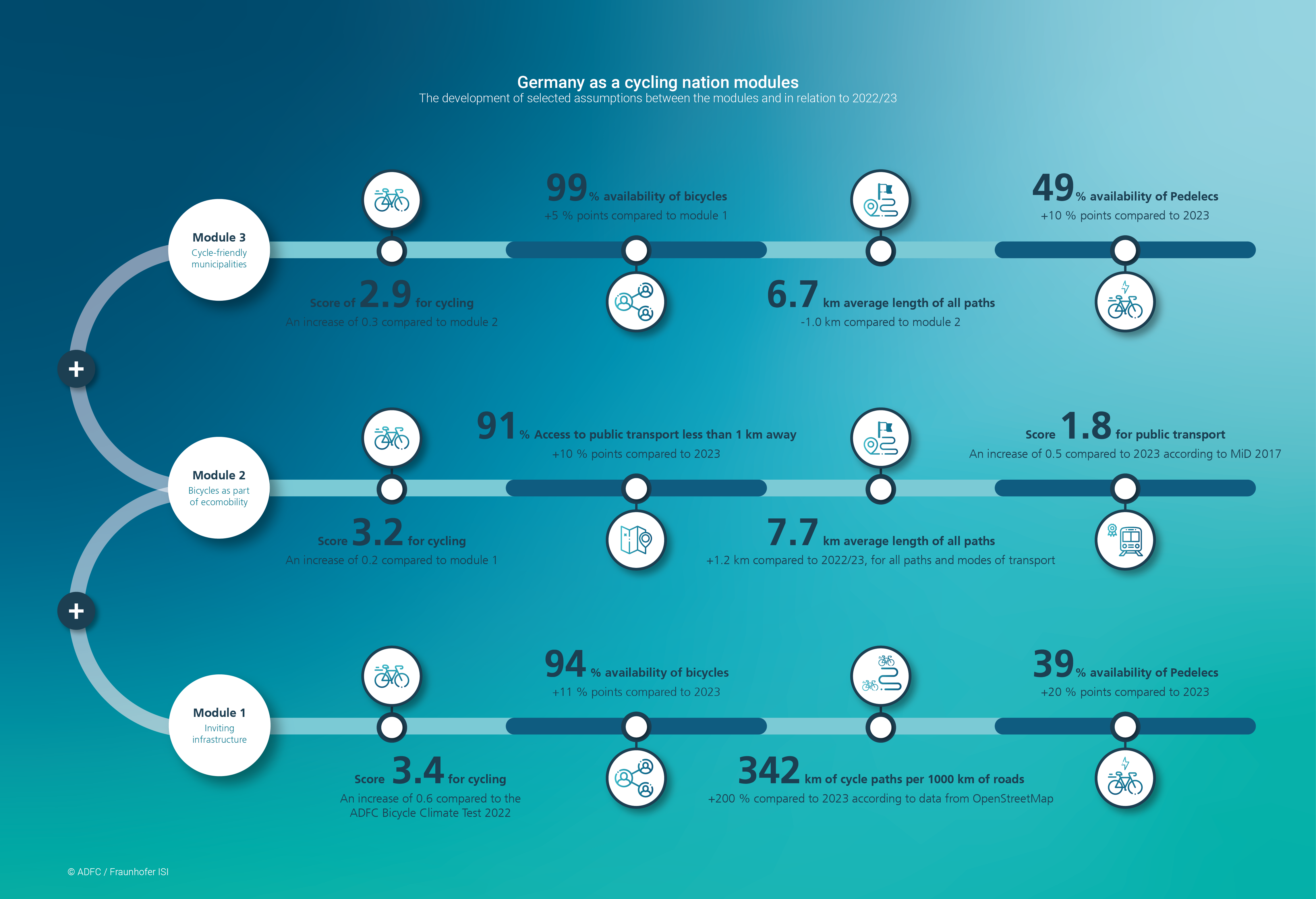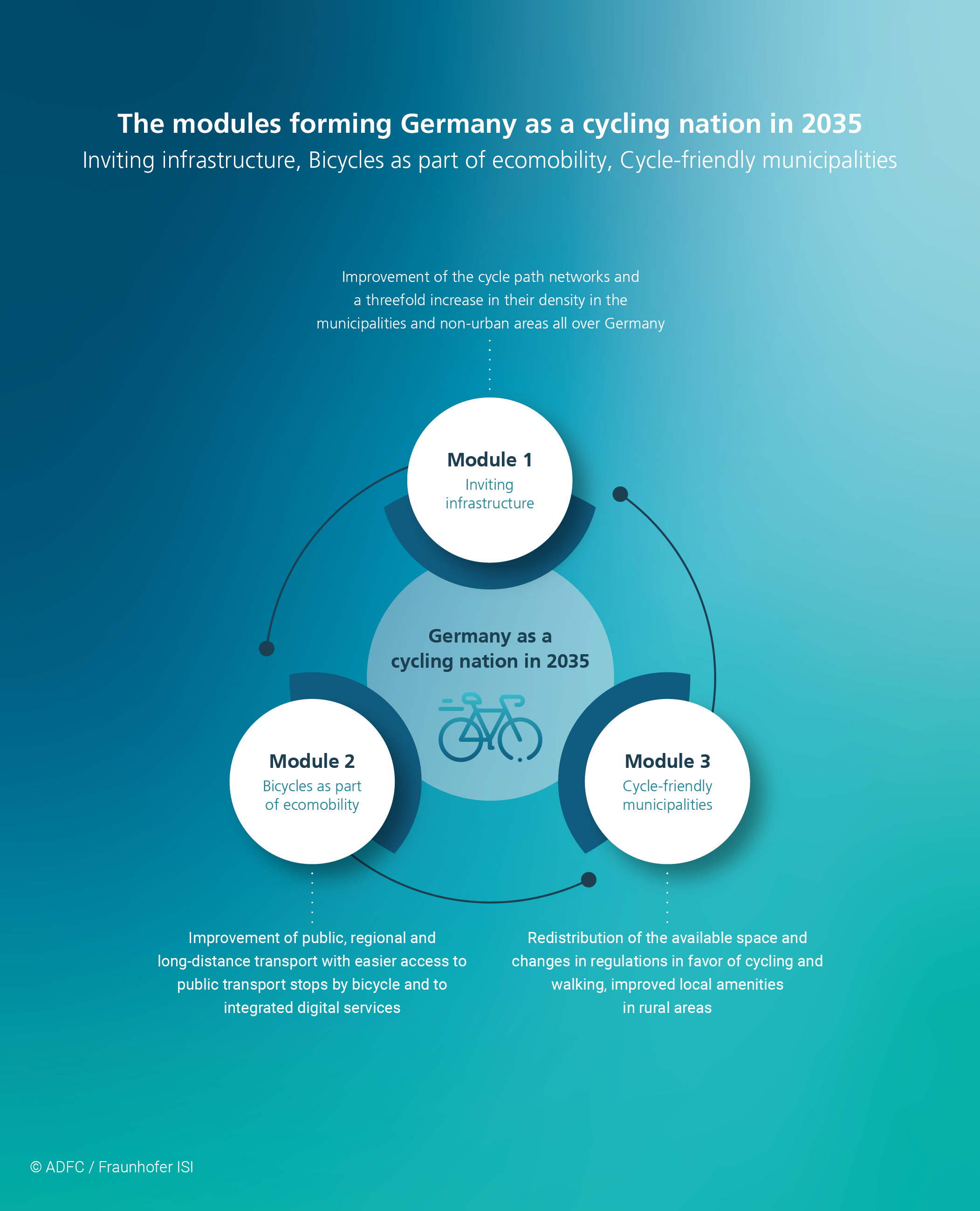Estimating the potential of cycling on behalf of the ADFC: The proportion of people travelling by bike in Germany could increase significantly with more political measures
On behalf of the German Cyclists' Federation (ADFC), researchers at Fraunhofer ISI carried out a new assessment of the potential for cycling in Germany. If comprehensive political measures aimed at becoming a bicycle-friendly country are implemented, the share of cycling on all routes up to 30 kilometres in length could increase to an average of 45 percent. An additional 19 million tonnes of CO2-equivalent (CO2e) greenhouse gases (GHG) could be saved in transport every year.
Germany aims to become an attractive cycling nation: The German government's National Cycling Plan (NCP) outlines the vision of ‘Germany as a cycling nation 2030’. More people travelling by bike is good for the climate, for cities and communities and for people's health. But how much cycling is possible in Germany? Up until now there were no reliable figures. This is because the usual traffic forecasts underestimate cycling, as they do not take into account the soft factors, such as the quality of the infrastructure, freedom from stress and a feeling of safety which are relevant when choosing a mode of transport.
In a study for the ADFC, researchers led by Dr Claus Doll from Fraunhofer ISI have taken a new approach to estimating potential: ‘For the first time, we have included crucial factors such as how continuous and dense the cycle path network is, the perception of safety in traffic, the links to buses and trains and the quality of public transport and local amenities in the municipalities in the analysis,’ explains Doll.
A new methodology for taking subjective factors into account in traffic forecasts
The predictive model is based on a statistical approach in the form of a multinomial logistic regression. What is new about the approach presented here is that instead of focusing purely on journey times and costs, which form the base of conventional model forecasts, it takes the perceived cycling environment into account as the real driver of mode of transport choice. To this end, route-specific preferences from the Mobility in Germany MiD 2017 survey were supplemented with data specific to individual districts. This included average scores from the ADFC bicycle climate test and the length of cycle paths from Open Street Map. The availability and quality of public transport and local amenities were added to create a consistent data set. Other factors that are not subject to political influences, such as demographic structure, topography or weather and season, were taken into account as control variables. The regression coefficients determined in this way were then used to calculate the scenarios. As a result, the predictive model generates trips, kilometers travelled and greenhouse gas emissions broken down according to mode of transport, type of region and distance for Germany in 2035.
This new approach to traffic forecasting is particularly relevant for cycling, as people's willingness to use their bikes regularly in everyday life depends very much on their subjective perception of safety in traffic and the quality of the infrastructure. The statistical model developed in this study is able to represent these subjective factors well. However, it is less suitable for depicting specific local conditions or financial, administrative and regulatory restrictions. Further limitations arise from the interleaving of the data set and the age of the behavioral data from the MiD 2017 survey. Due to the low market penetration of Pedelecs at the time, the 2017 survey presumably does not adequately reflect their potential, which is key for cycling in the future. Nevertheless, the closed statistical model developed here allows the impact assessment of the most relevant influencing factors such as the density of cycle networks, their quality, their links to public transport or the ownership of a driving license. As a result, the Fraunhofer researchers were able to determine the potential of cycling assuming stable behavioral patterns in 2017 and favorable framework conditions for cycling.
Accordingly, the researchers recommend fine-tuning the forecasting approach that was successfully applied in this study by eliminating any random influences due to the way the data is interleaved and, above all, by using the MiD survey from 2023/2024, which is not yet available. The main cause-effect relationships should ultimately be taken into account in conventional traffic forecasting models.
The three modules which form the “Germany as a cycling nation” model
The researchers developed their own model for a 'Germany as a cycling nation' made up of three expansion stages. The three modules relate to cycling infrastructure, public transportation and the bicycle-friendliness of municipalities. Each module highlights different aspects of a holistic and consistent policy for cycling:

For each of the three successive expansion stages, the scientists analyzed how the share of cycling in Germany and the GHG emissions generated through traffic might develop by 2035 if all assumptions are met, i.e. if the policy measures outlined are fully implemented. The results calculated here refer to trips up to 30 kilometers in length.
The share of cycling in Germany could increase threefold if additional policies are implemented compared to continuing current policies
Ultimately, the predictive model developed addresses the question of whether people in Germany would behave differently to the Dutch if we were to create comparable conditions for cycling in this country? The answer is: no. The potential for cycling identified is similar to the share of cycling that we are already seeing in cycling cities such as Utrecht, Amsterdam and Münster.
If all three modules of the “Germany as a cycling nation” model are implemented, the share of cycling in Germany could rise to 45% by 2035. This is a threefold increase compared to the development that could be expected with the current political course (15 percent share of cycling). The potential for cycling is particularly high in medium-sized cities, so-called regiopolitan urban regions, with up to 63% of all journeys being made by bike.
The majority of the modal shift takes place from motorized individual transport (MIT) in the form of cars or motorcycles to cycling. If the “Germany as a cycling nation” model is fully developed, almost half of all trips made now by MIT will be made by bicycle, which means that cars & co. will only account for 27 percent of daily trips of up to 30 km. However, the study also points out the risk that the expansion of cycling could also be at the expense of journeys on foot or by public transport. This competition within the environmental network must be addressed with holistic climate mobility plans.
If all three modules of “Germany as a cycling nation” are consistently implemented, an additional annual saving of 19 million tons of CO2e or 15% of greenhouse gases in land-based passenger transport as a whole (including all journeys over 30 km) would be possible compared to current transport policy. Compared to other options for decarbonizing transport, promoting cycling is a major measure that can be implemented relatively quickly. Dr. Claus Doll summarizes: “With the right political will and sufficient resources, Germany has the potential to become a cycling nation."
